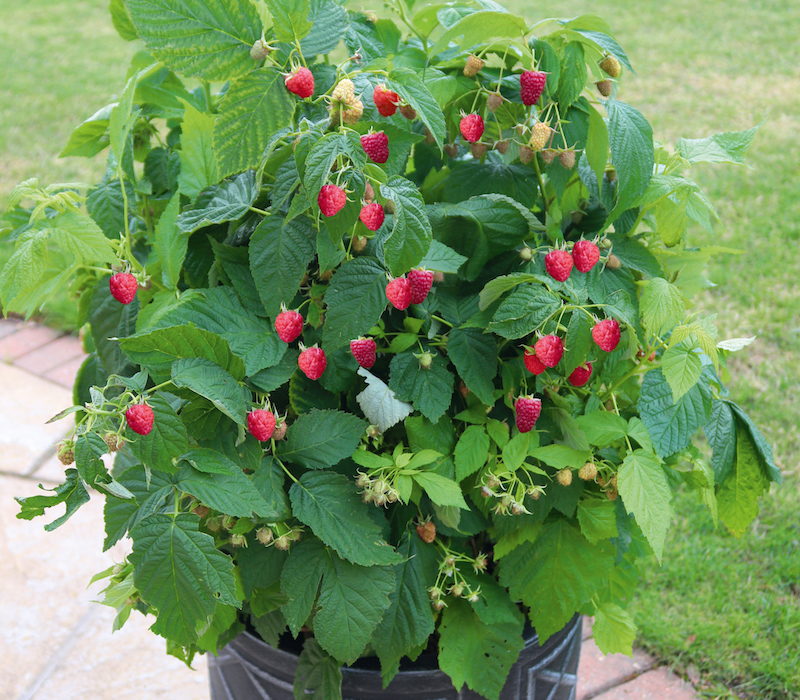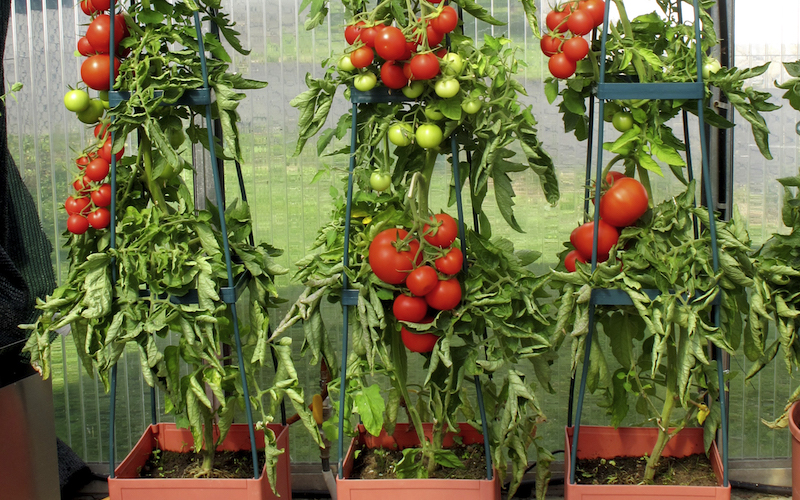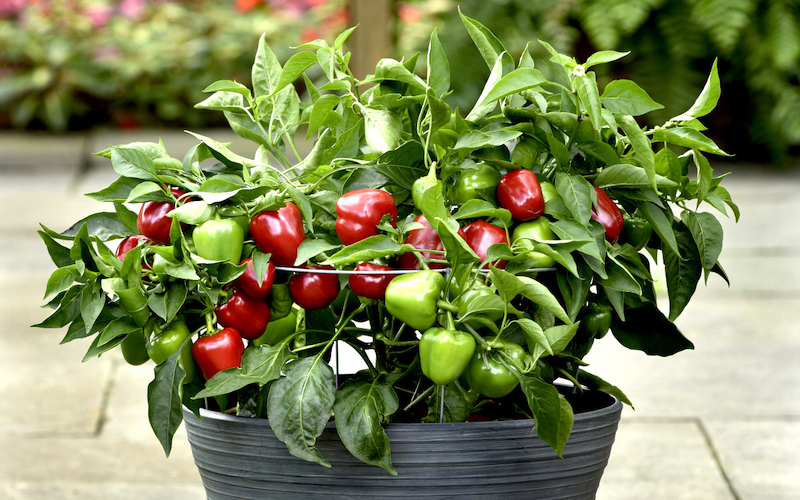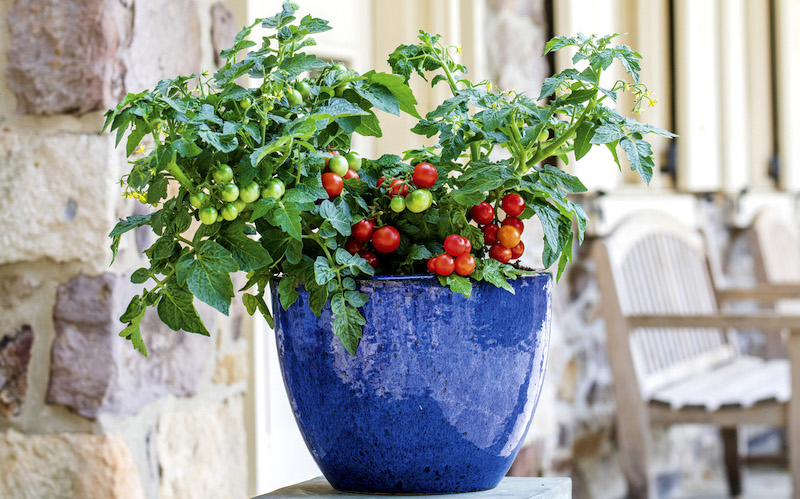Growing produce in containers on your patio or balcony is a great way to make good use of all your outdoor space. Not only does it result in lots of fresh food for the table, but fruit and vegetable plants also offer an attractive addition to traditional patio planting schemes. Here’s how to choose the best patio fruit plants and potted vegetable plants to grow in containers.
What’s the best container for growing vegetables?
When it comes to growing patio fruit and vegetables, any sunny deck, patio, backyard or balcony has the potential to produce a tasty crop – even a window box. The size of your outside space really doesn’t matter, but choosing the right containers for your fruit and veg is a must if all the different varieties are to have the correct environment to thrive.
When growing fruit and veg in containers, there are two main things to consider:
- The container must be large enough to sustain the plant. Typically, we suggest your containers should measure at least 23-25 cm (9-10″) in diameter. If you’re growing vegetables like leeks, potatoes, or any other root crops, you’ll need a deeper container. Salads and herbs will be fine in a shallower pot.
- There must be adequate drainage at the bottom of your containers. Waterlogged roots will rot and your plants will die.
Your pots can be ornamental or minimalist in design and made of any material that you wish, but do bear in mind the prevailing growing conditions. If you live in a drier climate or your patio doesn’t get much rain on it, plastic pots hold moisture better than terracotta. If your outside space is especially damp, terracotta pots will drain better and allow the soil to ‘breathe’, making them a better option.
Growing fruit and vegetables in bags

Image: Potato growing bags from Suttons
You might decide to do away with containers altogether and simply plant your crops in growbags. This method is both cheap and convenient and, because there are plenty of different grow bag holders and frames to choose from, this option can look attractive too. Lots of people grow tomatoes this way – the scent, flowers, and ripening fruit make a lovely patio display, plus you don’t have to go far to grab a tomato for your BBQ burgers. Read our article on the best crops to plant in growbags for more information.
Keep a lookout for specialist bags for growing things like herbs and strawberries. When space is at a premium, vertical growing systems make sense, and do remember your hanging baskets also offer the opportunity for experimenting with growing salad leaves or cherry tomatoes. For potatoes, try barrels or deep buckets which can lend a rustic feel to your patio display. Our article on growing potatoes in containers is full of helpful advice.
Growing fruit and veg in window boxes and planters

Image: Suttons
Use planters to add structure to your patio displays and grow flowers and veg together. Called companion planting, try some of the great traditional pairings like garlic chives alongside carrots, lavender with leeks, and borage with strawberries. And don’t forget that window box! Many salad leaves, radishes, spring onions and herbs are perfect for this kind of container.
The best compost for container vegetables

Image: Raspberry Plant ‘Summer Lovers Patio Red’ from Suttons
Once you’ve got your containers sorted and your planting scheme organised, you’ll need to consider your compost options. Different plants call for different growing conditions and choosing the right compost to fill your containers is important. Here are some of the basics to help you choose wisely:
- Multipurpose compost – suitable for most applications this comes in various blends and contains a good mix of nutrients, retains moisture well without waterlogging, and provides good holding for a wide variety of plants. Choose peat free if you can.
- Soil-based compost – often referred to as John Innes number 1,2, or 3, this compost is based on loam and the number refers to the amount of added nutrients. 1 is good for pricking out and potting on; 2 is suitable for the widest range of applications; 3 contains the most fertiliser and is best suited to trees, shrubs, bushes, and climbers. Soil-based compost is great for long-term use in containers and larger, taller plants will appreciate the denser soil to help keep them upright.
How to care for container-grown fruit and veg

Image: Self-Watering Tomato Towers from Suttons
The beauty of container-grown fruit and vegetable plants is that you can move the pots around to benefit from optimal growing conditions. For most crops, this means a bright, sunny and sheltered spot. Having said that, if your outside space is dark, gloomy, and damp, do make sure you choose plants which will thrive despite the lack of sunlight – kale and spinach will tolerate some shade as will blackcurrants and redcurrants, for example.
Because container-grown plants can only draw water from the moisture in the container, you must make sure you water regularly, especially during dry spells. This is particularly important during the period when fruit or veg is swelling – check your soil each day, and consider adding water-retaining crystals to the compost before planting.
Lots of varieties of fruit and veg will find enough nutrients in the compost. Other plants like tomatoes and beans will benefit from a weekly or fortnightly feed with a high potash tomato fertiliser. Simply check the instructions so that you know what to do.
Close planting avoids weeds, but keep a close eye on your containers for unwanted pests and treat as necessary.
What fruit and veg can I grow in patio containers?

Image: Sweet pepper plants from Suttons
A huge range of vegetables can be grown in containers, and ‘dwarf’ varieties are particularly suited to pot culture. Here are some of our favourites:
| Grow in 25-30cm (10-12″) pot | Plant in Growbag | Sow Seed | Plant Out | Sow Direct | Harvest | |
| Aubergine | 1 | 3 | Feb – Mar | May – Jun | – | Aug – Oct |
| Runner Beans | 4 | 8 | Apr | May – Jun | – | Jul – Oct |
| French Beans | 4 | 8 | Apr | May – Jun | – | Jul – Oct |
| Beetroot | Sow direct and thin to 2.5cm (1″) apart | Sow direct and thin to 2.5cm (1″) apart | – | – | Mar – Jul | Jun – Oct |
| Carrot | Sow direct and thing to 5-7 cm (2-3″) apart | (suitable for shallow rooting globe types only) | – | – | Feb – Jul | Jun – Oct |
| Courgette | 1 | 2 | Apr – May | Jul | – | Jul – Sep |
| Marrow (squash) | 1 | 2 | Apr – May | Jul | – | Jul – Sep |
| Leek (for salads) | Sow direct and thin to about 2cm ( apart | – | – | – | Apr – May | Jun – Oct |
| Lettuce | Sow direct and thin out | 15-20cm (6-8″) apart | – | – | May – Jul | May – Oct |
| Parsnip | Sow direct and thin out to 5cm (2″) apart | – | – | – | Feb – Jul | Jul – Oct |
| Peppers | 1 | 3 | Mar – Apr | Jun | – | Jul – Oct |
| Potatoes | 1 or 2 | – | – | Mar- Apr | – | Jun – Jul |
| Leaf Beet (Chard) | 8 | – | – | – | Apr – Jun | Jul – Oct |
| Leaf Salad | Sow direct finely – no need to thin out | Sow direct finely – no need to thin out | – | – | Apr – Oct | May – Oct |
| Salad Onions | Sow direct finely – no need to thin out | Sow direct finely – no need to thin out | – | – | Mar – May | Jul – Sep |
| Strawberries | 3 | 30cm (12″) apart | – | Feb- Mar | – | Jun – Aug |
| Tomatoes | 1 | 3 | Mar – Apr | Jun | – | Jul – Sep |
| Turnips | Sow direct and thin to 2.5cm (1″) apart | Sow direct and thin to 2.5cm (1″) apart | – | – | Apr – Jul | Jun – Oct |
For more information about the vegetables that you can grow in containers, click on the letter to expand the relevant column.
Aubergine
- Contains vitamins E & K. Rich in potassium, folate magnesium & fibre.
- Sow aubergine seeds : February – March at a temperature of 16-18°C (60-65°F). Traditionally sown in a greenhouse, but an electrically heated propagator on a sunny windowsill is just as good. When the seedlings are large enough to handle transplant into 9cm (3½”) pots and keep indoors. Pot on when necessary into 13cm (5″), and finally into 23cm (9″) pots providing a cane for support. The container can be placed out of doors in a sunny sheltered position in late May/early June once all danger of frost is passed.
Beans (Dwarf French & Runner)
- Dwarf French Beans contain Vitamin A – Runner Beans are high in Vitamin C.
- Sow Runner Beans: indoors during April and plant outdoors at the end of May/early June once the danger of frost has passed. Alternatively, sow direct into the container in May and grow on in sunny position. Almost any variety of Dwarf French Beans are suitable for pot growing, and with a wide range of pod colour of these can be a very attractive feature, ranging from golden-yellow, through green, bright red and purple. Delicious and beautiful! Choose a low growing variety of Runner Beans for pot culture. Four plants are sufficient for a 25cm (10″) pot.
Beetroot
- Roots rich in potassium and folate + vitamin C. Tops – high concentration of beta carotene, calcium and iron.
- Sow beetroot seeds: Thinly, direct into the container from late March to the end of July. Thin seedlings to 2.5cm (1″) and harvest after about 12 weeks when the roots are the size of ping-pong balls. Sow at regular intervals for a continuous supply.
Blueberry
- Rich in Vitamin C & A, high in antioxidants.
- Blueberry plants will grow well on the patio in a large pot of moist ericaceous (lime-free) compost. The bushes make a striking display right through the year from the delicate rusty red leaf tips in spring to the stunning colours of autumn. This fruit is one of a group very high in vitamins and minerals thought to have good health benefits, often known as superfoods.
Carrots
- High in Vitamin A.
- Sow carrot seeds: thinly direct into pots and cover lightly with compost. Sow fortnightly from the end of February through to early July. Sow seed thinly and then thin out seedlings to 5-7cm (2-3″) apart. The earlier sowings should be made in a greenhouse or polytunnel.
Courgettes & Marrows
- High in Vitamins A, C & E.
- Sow courgette seeds and marrow seeds: one seed to a small pot indoors from mid-April to Early May. Once established transplant the young plants one to a 25cm (10″) pot and place in a sunny position once the danger of frost has passed.
Leaf Beet
- High in Vitamin A.
- Sow leaf beet and chard seeds: April to June direct into its container – roughly 8 plants to a 25cm (10″) pot. There are some very colourful varieties that make a great display. Keep well watered
Leaf Salad
- Sow lettuce and leaf seeds: Fortnightly outdoors from April to October. The first cutting can be taken approximately 14-21 days later leaving 3cm (1¼”) for re-growth, you should get about 2-3 clippings from each sowing.
Leeks
- High in Potassium, folic acid and vitamins A & C.
- Sow leek seeds thinly in April/May and aim for plants about 2cm apart. Harvest within 10-12 weeks while they are still young and tasty. Fortnightly sowings of leek seeds will ensure a constant supply for salads, stir fries or lightly steaming.
Lettuce
- Source of beta-carotene and vitamin A.
- Sow lettuce: February to July outdoors. Thin the plants to 15-20cm (6-8″) apart. Remember that the thinnings are good for salads too! Sowing at fortnightly intervals ensures a constant supply. Keep the plants well watered throughout the summer.
Parsnip
- Contains vitamin C & potassium, plus energy-boosting starchy carbohydrates.
- Sow parsnip seeds: Late February to mid-June thinly in containers – thin out to 5 cm (2″) apart. Harvest 18-20 weeks from sowing.
Peppers
- Rich in vitamins A & C.
- Sow sweet pepper seeds: March or April at a temperature of 16-18°C (60-65°F).
- Grow peppers in a greenhouse or propagator. When large enough to handle, transplant into 9cm (3½”) pots. Finally, the plants can be potted up either one plant to a 25cm (10″) pot or 3 to a grow bag – a cane may be required by taller varieties. Place outside once the danger of frost has passed.
Seed potatoes
- A good source of vitamin C + potassium, protein and fibre.
- Choose one of the early varieties of seed potatoes. Plant one to three tubers according to the size of the container, or six for a specially designed potato barrel. Many kits are now available with good guidance for potato growing. The tubers should be started into growth (chitted) before planting. Place the tubers in a dish or egg box, sprouting eyes uppermost, in a cool, frost-free, light place. Once the resulting shoots are approximately an inch in length they are ready for planting. Place a layer of compost in the base of the container. Plant the tubers covering with about 5 cm (2″) of compost. As the shoots develop further top up with compost in 10cm (4″) layers but do not cover the growing tip – repeat until the container is full. Once the plants begin to flower the crop should be ready for harvesting.
Salad Onions
- Sow salad onion seeds: thinly, from March-May, directly into containers. Keep well watered during dry spells. A succession of fortnightly sowings will ensure pickings from June to September.
Strawberries
- Strawberries are rich in vitamin C & high in folate and fibre.
- Space is no issue where strawberries are concerned as they grow well in pots and baskets. Any variety will grow well in a sunny spot but if you choose everbearer types that fruit throughout the summer, you can extend the growing season by taking them indoors late in the season. Grow bags or specialised strawberry pots are excellent, but most large pots are suitable, and the number of plants required will be dictated by the container size.
- Hanging Baskets: Suspending strawberries off the ground is a great way to keep slugs and snails away from them. Three to four strawberry plants should be sufficient for a hanging basket.
Tomatoes
- High in antioxidants, vitamin C & Lycopene.
- Sow tomato seeds: March or April indoors at a temperature of 16-18°C (60-65°F). Transplant seedlings into 9cm (3½”) pots when large enough to handle. Most commonly grown in grow bags, tomatoes will do well in any large container that has sufficient drainage. A general guide would be three plants to a grow bag and one to a 25cm (10″) pot. Provide cane supports for upright varieties. For hanging baskets choose a cherry fruited variety suitable for basket culture. One plant is enough for one basket. Keep well fed and watered. All varieties except the bush types need the side shoots removing as they develop and should be stopped when four trusses have been produced. Begin feeding once the flowers start to set.
Turnip
- High in vitamin C & fibre.
- Sow turnip seeds: April to July – sow thinly direct into the container. White ping-pong sized roots should be produced approximately 7 weeks from sowing. Cook in the usual way or try them raw in salads. The tops can be steamed and used as greens.
10 handy hints and money-saving tips

Image: Tomato plant ‘Veranda Red’ from Suttons
- Keep picking Runner Beans, French Beans and Courgettes, even if you need to give them away or freeze them. This encourages the plants to keep flowering and producing crops.
- Keep containers topped up with water. Many vegetables bolt (run to seed) or split if the water supply is erratic.
- Grow a selection of lettuce varieties to give your container an interesting range of colour and leaf shapes – this also makes for beautiful salads.
- Make fortnightly sowings of salad leaves to maintain fresh supplies throughout the summer.
- Remove the side shoots of cordon (single stem) tomato varieties when small to avoid damage to the stem.
- For early beans, start the container indoors and move it outside once the danger of frost has passed
- For an extended strawberry season, choose an ever-bearer variety. Keep the container indoors in the early season and bring it back inside later to prolong the cropping period.
- Protect your pots from slug attack with copper tape around the pot – they won’t cross it.
- Sow some marigold seeds in with your tomato plants to discourage whitefly.
- Keep some polythene or fleece handy to cover young plants in bad weather. Always protect them from frost should the temperature fall significantly.
Growing fruit and veg in patio containers adds a new dimension to your decorative planting and results in lots of healthy produce for the table. It’s a win-win, so make sure you give it a go this growing season.
For more advice on making the most of your patio garden, watch our video below.
Lead image: Milan Rybar/Shutterstock
Last Updated on February 10, 2025 by Suttons Horticultural Team




